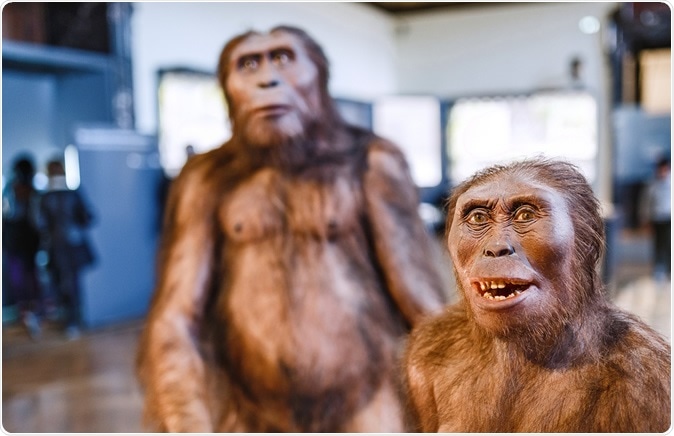Ancient human microbiomes are under the microscope for what they tell scientists about the people of long ago. A new study published in the journalFrontiers in Ecology and Evolutionin February 2020 shows that the gut microbiome can adapt to new bacterial exposures, which allows humans to migrate to new locations successfully.
While the social structure of primates is known to change the structure of their microbiomes, the reverse may also be true, according to this new theory. The scientists hypothesize that adaptive microbiomes are the function of human adaptability and the basis of successful human living in a range of environments.

VIENNA, MUSEUM OF NATURAL HISTORY, AUSTRIA: Installation demonstrating the prehistoric ancestors of man homo erectus. Image Credit: Shutterstock
Nature and Science news: The study
Using data from earlier research, the scientists compared the microbiomes from specific sites, namely, the stomach, the intestines, the armpits, and in fermented foods, among non-human primates, apes, and humans to examine the way the human microbiome changes over different locations and with different lifestyles. Both the number and the type of species show changes, as well as the functions carried out by the microbiomes.
Nature and Science news: Spreading microbes around
Moving to a different location typically means facing new foods, having to cope with new disease-causing organisms, and using new tools to get and to process food. This is made possible by the microbiome's ability to adapt, by digesting and detoxifying the foods in different locales. This makes it easier to survive new diseases and to adapt to a range of new environments. This contributed to the spread of the human race around the world.
An important aspect is that microbes are also spread around by microbes so that they also adapt to local conditions. Not only did the microbes spread between humans but between humans and the foods they ate.
One example is fermentation, where the microbial digestion of foods begins outside the body using microbes that are also found within the gut. The benefit of fermentation is that it allows the storage of food so that groups of humans can stay together in one place, forming a broader community. Fermented foods include many kinds of cheese, yogurts, and curds, wines and vinegars. The microbes found in these foods are part of the extended microbiomes of the human hosts.
In fermentation, the microbes cannot survive outside the body of the host and can only be transferred among the host animals themselves by close contact. The consumption of fermented foods led to the reintroduction of the microbes into the human group, so that eventually, the microbiota of the humans in that community shared more significant similarities compared to that from other human groups.
Nature and Science news: Implications
Comparisons between the microbiomes of different groups throw up some questions and theories about how the human stomach requires its acidic internal environment, how the gut microbiomes develop their unique structures and the presence of fermentation in early human society.
The scientists think that social behavior among humans and other primates is fostered by the interdependence of microbes in their gut and other parts of the body, which were passed around by the social conditions and thus became fit to survive the changing conditions of expanding human territory.
Researcher Rob Dunn says, "We outsourced our body microbes into our foods. That could well be the most important tool we ever invented. But it is a hard tool to see in the past and so we don't talk about it much. Stone artifacts preserve, but fish or beer fermented in a hole in the ground doesn't."
The scientists admit that their conclusions are hypothetical. Still, they hope that further research by paleoanthropologists, environmental scientists, and medical scientists will be able to validate these theories by testing them out.
Says Dunn, "We are hoping the findings will change some questions and that other researchers will study the consequences of changes in the human microbiome. Hopefully, the next decade will see more focus on microbes in our past and less on sharp rocks."
Journal reference:
Dunn, R. R., Amato, K., Archie, E., et al. The internal, external and extended microbiomes of hominins. Frontiers in Ecology and Evolution. doi: 10.3389/fevo.2020.00025.https://www.frontiersin.org/articles/10.3389/fevo.2020.00025/full
Via newsapi.org. Read more here:
https://www.trendard.com









0 Comments